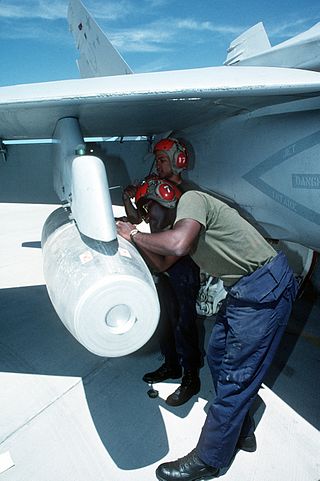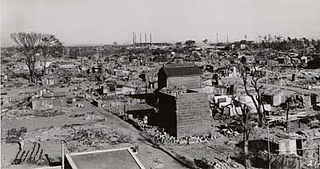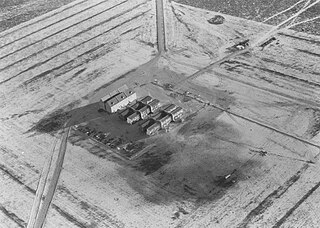
Napalm is an incendiary mixture of a gelling agent and a volatile petrochemical. The name is a portmanteau of two of the constituents of the original thickening and gelling agents: coprecipitated aluminium salts of naphthenic acid and palmitic acid. A team led by chemist Louis Fieser originally developed napalm for the US Chemical Warfare Service in 1942 in a secret laboratory at Harvard University. Of immediate first interest was its viability as an incendiary device to be used in fire bombing campaigns during World War II; its potential to be coherently projected into a solid stream that would carry for distance resulted in widespread adoption in infantry flamethrowers as well.

The Bombing of Tokyo was a series of firebombing air raids by the United States Army Air Force during the Pacific campaigns of World War II. Operation Meetinghouse, which was conducted on the night of 9–10 March 1945, is the single most destructive bombing raid in human history. 16 square miles of central Tokyo were destroyed, leaving an estimated 100,000 civilians dead and over one million homeless. In comparison, the atomic bombing of Hiroshima in August 1945 resulted in the immediate death of between 70,000 and 150,000 people.

Firebombing is a bombing technique designed to damage a target, generally an urban area, through the use of fire, caused by incendiary devices, rather than from the blast effect of large bombs. In popular usage, any act in which an incendiary device is used to initiate a fire is often described as a "firebombing".

Incendiary weapons, incendiary devices, incendiary munitions, or incendiary bombs are weapons designed to start fires or destroy sensitive equipment using fire, using materials such as napalm, thermite, magnesium powder, chlorine trifluoride, or white phosphorus. Though colloquially often known as bombs, they are not explosives but in fact are designed to slow the process of chemical reactions and use ignition rather than detonation to start or maintain the reaction. Napalm, for example, is petroleum especially thickened with certain chemicals into a 'gel' to slow, but not stop, combustion, releasing energy over a longer time than an explosive device. In the case of napalm, the gel adheres to surfaces and resists suppression.

The bombing of Kobe in World War II on March 16 and 17, 1945, was part of the strategic bombing campaign waged by the United States against military and civilian targets and population centers during the Japan home islands campaign in the closing stages of World War II. The city would be bombed again in later months.

During World War II, Allied forces conducted air raids on Japan from 1942 to 1945, causing extensive destruction to the country's cities and killing between 241,000 and 900,000 people. During the first years of the Pacific War these attacks were limited to the Doolittle Raid in April 1942 and small-scale raids on military positions in the Kuril Islands from mid-1943. Strategic bombing raids began in June 1944 and continued until the end of the war in August 1945. Allied naval and land-based tactical air units also attacked Japan during 1945.

The M33 cluster bomb, also known as the (M33) Brucella cluster bomb, was a U.S. biological cluster bomb developed in the early 1950s and deployed in 1952. It was the first standardized biological weapon in the U.S. arsenal.

Operation Big Itch was a U.S. entomological warfare field test using uninfected fleas to determine their coverage and survivability as a vector for biological agents. The tests were conducted at Dugway Proving Ground in 1954.
The E14 munition was a cardboard sub-munition developed by the United States biological weapons program as an anti-crop weapon. In a series of field tests in 1955, the E14 was loaded with fleas and air-dropped.

The Bombing of Shizuoka in World War II on June 19, 1945, was part of the strategic bombing campaign waged by the United States against military and civilian targets and population centers during the Japan home islands campaign in the closing stages of World War II.

The Bombing of Hiratsuka in World War II was part of the strategic bombing campaign waged by the United States against military and civilian targets and population centers during the Japan home islands campaign in the closing states of World War II.

Japanese Village was the nickname for a range of houses constructed in 1943 by the U.S. Army in the Dugway Proving Ground in Utah, roughly 100 kilometers (62 mi) southwest of Salt Lake City.

The Bombing of Aomori in World War II on July 28, 1945, was part of the strategic bombing campaign waged by the United States against military and civilian targets and population centers during the Japan home islands campaign in the closing stages of World War II.
The Bombing of Chiba in World War II was part of the strategic bombing campaign waged by the United States of America against military and civilian targets and population centers during the Japan home islands campaign in the closing stages of World War II, and included two separate air raids in 1945. The second, and larger, air raid of July 6, 1945 is also referred to as the “Tanabata Air Raid”, as it occurred on the night of a traditional festival.

The Bombing of Kōfu in World War II was part of the strategic bombing campaign waged by the United States against military and civilian targets and population centers of the Empire of Japan during the Japan home islands campaign in the closing states of World War II.
The Bombing of Utsunomiya in World War II on July 12, 1945, was part of the strategic bombing campaign waged by the United States against military and civilian targets and population centers during the Japan home islands campaign in the closing stages of World War II.

On the night of 9/10 March 1945, the United States Army Air Forces (USAAF) conducted a devastating firebombing raid on Tokyo, the Japanese capital city. This attack was code-named Operation Meetinghouse by the USAAF and is known as the Great Tokyo Air Raid in Japan. Bombs dropped from 279 Boeing B-29 Superfortress heavy bombers burned out much of eastern Tokyo. More than 90,000 and possibly over 100,000 Japanese people were killed, mostly civilians, and one million were left homeless, making it the most destructive single air attack in human history. The Japanese air and civil defenses proved largely inadequate; 14 American aircraft and 96 airmen were lost.
The Bombing of Fukui in World War II on July 19, 1945, was part of the strategic bombing campaign waged by the United States against military and civilian targets and population centers during the Japan home islands campaign in the closing stages of World War II.
The Bombing of Gifu in World War II on July 9, 1945 was part of the strategic bombing campaign waged by the United States of America against military and civilian targets and population centers during the Japan home islands campaign in the closing stages of World War II.














